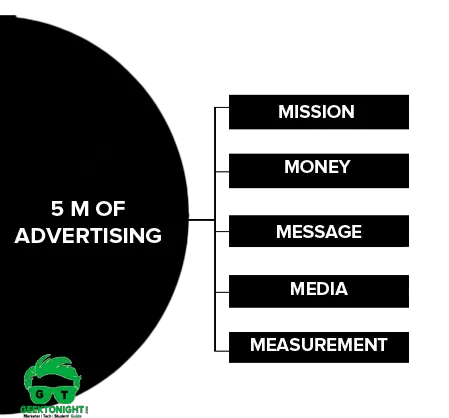5 M of Advertising
5 M’S of Advertising are:
Table of Content
Every organizations or marketing communication firm handle their advertising in different ways.
In small firms, advertising is handled by executives or account managers in the sales or marketing department, who works with an advertising agency.
A large company often set up its own advertising department or hire an advertising agency to prepare their advertising programs.
In developing an advertising program, the marketing managers always start by identifying the target market and the buyer’s intentions.
Then they make the five major decisions in developing an advertising program, called the 5 M’s of Advertising, viz.
5 M of Advertising
- Mission: what are the objectives of the advertising campaign?
- Money: how much budget they required to achieve the objectives?
- Message: what message and message strategy will be followed?
- Media: what type of media vehicle/s will be used to deliver the message?
- Measurement: how should be the results of the advertising campaign or programme will be evaluated?

Mission
Advertising Objectives can be classified as to whether their aim is:
- To inform: This aim of Advertising is generally true during the pioneering stage of a product category, where the objective is building a primary demand. This may include :
- Telling the market about a new product
- Suggesting new uses for a product
- Informing the market for a price change
- Informing how the product works
- Describing available services
- Correcting false impressions
- Reducing buyers’ fears
- Building a company image
- To persuade: Most advertisements are made with the aim of persuasion. Such advertisements aim at building a selective brand.
- To remind: Such advertisements are highly effective in the maturity stage of the product. The aim is to keep the consumer thinking about the product.
Money
This M deals with deciding on the Advertising Budget. The advertising budget can be allocated based on:
• Departments or product groups
• The calendar
• Media used
• Specific geographic market areas
There are five specific factors to be considered when setting the Advertising budget.
- Stage in PLC: New products typically receive large advertising budgets to build awareness and to gain consumer trial. Established brands are usually supported with lower advertising budgets as a ratio to sales.
- Market Share and Consumer base: high-market-share brands usually require less advertising expenditure as a percentage of sales to maintain their share. To build share by increasing market size requires larger advertising expenditures. Additionally, on a cost – per – impressions basis, it is less expensive to reach consumers of a widely used brand them to reach consumers of low-share brands.
- Competition and clutter: In a market with a large number of competitors and high advertising spending, a brand must advertise more heavily to be heard above the noise in the market. Even simple clutter from advertisements not directly competitive to the brand creates the need for heavier advertising.
- Advertising frequency: the number of repetitions needed to put across the brand’s message to consumers has an important impact on the advertising budget.
- Product substitutability: brands in the commodity class (example cigarettes, beer, soft drinks) require heavy advertising to establish a different image. Advertising is also important when a brand can offer unique physical benefits or features.
Message
Message generation can be done in the following ways:
- Inductive: By talking to consumers, dealers, experts and competitors. Consumers are a major source of good ideas. Their feeling about the product, its strengths, and weaknesses gives enough information that could aid the Message generation process.
- Deductive: John C. Maloney proposed a framework for generating Advertising Messages. According to him, a buyer expects four types of rewards from a product:
- Rational
- Sensory
- Social
- Ego Satisfaction.
Buyers might visualize these rewards from:
• Results-of-use Experience
• Product-in-use Experience
• Incidental-to-use Experience
The Matrix formed by the intersection of these four types of rewards and the three types of experiences is given below.
Message evaluation and selection
Before deciding about the final message to be sent, a good advertiser always evaluates the various alternative messages. Often a good advertising campaign always focuses on the at least one core selling proposition of the organization/product or services.
The advertising message can be rated on its desirability, exclusiveness and believability. The message must and always first say something desirable or interesting about the product or services.
And the message must also say something exclusive or distinct that does not apply to every brand in the product category. Above all, the message must be believable or provable.
Message execution
The impact of a message depends not only upon what is said but also on how it is said. Some advertisement aims for rational positioning and others for emotional positioning. While executing a message the style, tone, words, and format for executing the message must be kept in mind.
Media
The next ‘M’ to be considered while making an Advertisement Program is the Media through which the advertising message is communicated for the prospects.
Following are the steps which generally considered at the time of deciding and choosing the advertising media or the media vehicle to transfer the advertising message.
- Step V: Deciding on the geographical allocation of the media vehicle
- Step IV: Deciding on the timing of the media vehicle.
- Step III: Selecting specific media vehicle within consideration of all supporting factors.
- Step II: Choosing measure media vehicles among available media
- Step I: Deciding on the reach, frequency and impact of the media
Measurement
The evaluation of the effectiveness of the advertising campaign or advertising programme is very important as it always helps in preventing the further wastage of money and help in making necessary correction that are significant and vital for the further advertising programme.
Researching the effectiveness of the advertisement is the most used method of evaluating the effectiveness of the Advertisement Program. Research can be in the form of:
• Communication-Effect Research
• Sales-Effect Research
There are two ways of measuring advertising effectives. They are:
- Pre-testing: It is the assessment of an advertisement for its effectiveness before it is actually used. It is done through.
- Concept testing: how well the concept of the advertisement is. This is being done by taking an expert opinion on the concept of the ad.
- Test commercials: test trial of the advertisement to the sample of people
- Finished testing
- Concept testing: how well the concept of the advertisement is. This is being done by taking an expert opinion on the concept of the ad.
- Post-testing: It is the assessment of an advertisement’s effectiveness after it has been used. It is done in two ways:
- Unaided recall: a research technique that asks how much of an ad a person remembers during a specific period of time
- Aided recall: a research technique that uses clues to prompt answers from people about ads they might have seen
- Unaided recall: a research technique that asks how much of an ad a person remembers during a specific period of time
5 M’s Of Advertising Example
5 M’s Of Advertising of “The Sundrop Campaign”
- Mission: Sales goals: Leadership in the edible refined oil
segment- Advertising Goals &Communication task:
- Position Sundrop as the healthy oil for healthy
people - Ensure that this did not erode the delivery of
the taste benefit. - Positioning had to be perceptually as far away
from Saffola. - Young, modern and premium feel
- Execution had to be distinct and original to
stand out from the clutter
- Money:
- Stage in PLC: Introductory, therefore relatively large expenditure
- Market share: new product
- Competitors: Saffola (Safflower oil) also used the health platform but was associated with heart patients and less taste Flora and Sunola (Sunflower oils).
- Message: Health was chosen as the platform, along with a supporting claim for taste. People who were healthy and energetic were concerned about the long-term prospects of their health. Thus ‘Health’
- Was related to maintenance of good health
- Was applicable to all members of the family
- Was characterized by lively energetic people
- Thus the message and (positioning): ‘The Healthy Oil for Healthy People’
- Media: Primary media: Television ad 30 seconds. Print ad
- Measurement:
- Within 6 months, Sundrop became the largest selling refined sunflower oil.
- Redefined the category and expanded the Sunflower oil segment from 2.71% to 23% in 6 months, and 42% in 2016
- Still the largest selling sunflower oil brand holds 15% of branded oil market.
- The ad was shown for over 10 years as the main theme film.
Marketing Management
(Click on Topic to Read)
- What Is Market Segmentation?
- What Is Marketing Mix?
- Marketing Concept
- Marketing Management Process
- What Is Marketing Environment?
- What Is Consumer Behaviour?
- Business Buyer Behaviour
- Demand Forecasting
- 7 Stages Of New Product Development
- Methods Of Pricing
- What Is Public Relations?
- What Is Marketing Management?
- What Is Sales Promotion?
- Types Of Sales Promotion
- Techniques Of Sales Promotion
- What Is Personal Selling?
- What Is Advertising?
- Market Entry Strategy
- What Is Marketing Planning?
- Segmentation Targeting And Positioning
- Brand Building Process
- Kotler Five Product Level Model
- Classification Of Products
- Types Of Logistics
- What Is Consumer Research?
- What Is DAGMAR?
- Consumer Behaviour Models
- What Is Green Marketing?
- What Is Electronic Commerce?
- Agricultural Cooperative Marketing
- What Is Marketing Control?
- What Is Marketing Communication?
- What Is Pricing?
- Models Of Communication
Sales Management
- What is Sales Management?
- Objectives of Sales Management
- Responsibilities and Skills of Sales Manager
- Theories of Personal Selling
- What is Sales Forecasting?
- Methods of Sales Forecasting
- Purpose of Sales Budgeting
- Methods of Sales Budgeting
- Types of Sales Budgeting
- Sales Budgeting Process
- What is Sales Quotas?
- What is Selling by Objectives (SBO)?
- What is Sales Organisation?
- Types of Sales Force Structure
- Recruiting and Selecting Sales Personnel
- Training and Development of Salesforce
- Compensating the Sales Force
- Time and Territory Management
- What Is Logistics?
- What Is Logistics System?
- Technologies in Logistics
- What Is Distribution Management?
- What Is Marketing Intermediaries?
- Conventional Distribution System
- Functions of Distribution Channels
- What is Channel Design?
- Types of Wholesalers and Retailers
- What is Vertical Marketing Systems?
Marketing Essentials
- What is Marketing?
- What is A BCG Matrix?
- 5 M'S Of Advertising
- What is Direct Marketing?
- Marketing Mix For Services
- What Market Intelligence System?
- What is Trade Union?
- What Is International Marketing?
- World Trade Organization (WTO)
- What is International Marketing Research?
- What is Exporting?
- What is Licensing?
- What is Franchising?
- What is Joint Venture?
- What is Turnkey Projects?
- What is Management Contracts?
- What is Foreign Direct Investment?
- Factors That Influence Entry Mode Choice In Foreign Markets
- What is Price Escalations?
- What is Transfer Pricing?
- Integrated Marketing Communication (IMC)
- What is Promotion Mix?
- Factors Affecting Promotion Mix
- Functions & Role Of Advertising
- What is Database Marketing?
- What is Advertising Budget?
- What is Advertising Agency?
- What is Market Intelligence?
- What is Industrial Marketing?
- What is Customer Value
Consumer Behaviour
- What is Consumer Behaviour?
- What Is Personality?
- What Is Perception?
- What Is Learning?
- What Is Attitude?
- What Is Motivation?
- Segmentation Targeting And Positioning
- What Is Consumer Research?
- Consumer Imagery
- Consumer Attitude Formation
- What Is Culture?
- Consumer Decision Making Process
- Consumer Behaviour Models
- Applications of Consumer Behaviour in Marketing
- Motivational Research
- Theoretical Approaches to Study of Consumer Behaviour
- Consumer Involvement
- Consumer Lifestyle
- Theories of Personality
- Outlet Selection
- Organizational Buying Behaviour
- Reference Groups
- Consumer Protection Act, 1986
- Diffusion of Innovation
- Opinion Leaders
Business Communication
- What is Business Communication?
- What is Communication?
- Types of Communication
- 7 C of Communication
- Barriers To Business Communication
- Oral Communication
- Types Of Non Verbal Communication
- What is Written Communication?
- What are Soft Skills?
- Interpersonal vs Intrapersonal communication
- Barriers to Communication
- Importance of Communication Skills
- Listening in Communication
- Causes of Miscommunication
- What is Johari Window?
- What is Presentation?
- Communication Styles
- Channels of Communication
- Hofstede’s Dimensions of Cultural Differences and Benett’s Stages of Intercultural Sensitivity
- Organisational Communication
- Horizontal Communication
- Grapevine Communication
- Downward Communication
- Verbal Communication Skills
- Upward Communication
- Flow of Communication
- What is Emotional Intelligence?
- What is Public Speaking?
- Upward vs Downward Communication
- Internal vs External Communication
- What is Group Discussion?
- What is Interview?
- What is Negotiation?
- What is Digital Communication?
- What is Letter Writing?
- Resume and Covering Letter
- What is Report Writing?
- What is Business Meeting?
- What is Public Relations?
Business Law
- What is Business Law?
- Indian Contract Act 1872
- Essential Elements of a Valid Contract
- Types of Contract
- What is Discharge of Contract?
- Performance of Contract
- Sales of Goods Act 1930
- Goods & Price: Contract of Sale
- Conditions and Warranties
- Doctrine of Caveat Emptor
- Transfer of Property
- Rights of Unpaid Seller
- Negotiable Instruments Act 1881
- Types of Negotiable Instruments
- Types of Endorsement
- What is Promissory Note?
- What is Cheque?
- What is Crossing of Cheque?
- What is Bill of Exchange?
- What is Offer?
- Limited Liability Partnership Act 2008
- Memorandum of Association
- Articles of Association
- What is Director?
- Trade Unions Act, 1926
- Industrial Disputes Act 1947
- Employee State Insurance Act 1948
- Payment of Wages Act 1936
- Payment of Bonus Act 1965
- Labour Law in India
Brand Management






